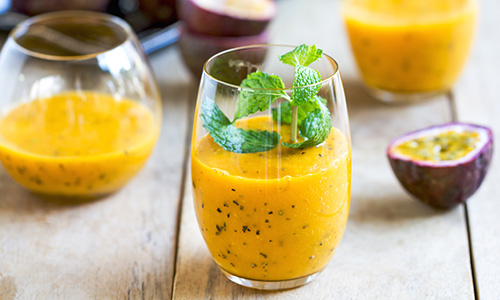
Ingredients for 4 glasses:
- ½ ripe honeydew or cantaloupe melon (approx. 500 g)
- 200 g strawberries
- 1 nectarine
- 150 g apricots
- 3 tbsp brown sugar
- 6 tbsp lime juice
- 12 ice cubes
- 4 tbsp (10 g each) collagen peptide
Preparation:
- Cut melon into sections, removing seeds and rind from sections. Cut melon into small pieces. Clean, wash and cut strawberries into half.
- Slice an X into the nectarine and apricots, briefly dip the fruit into boiling water and rinse in cold water. Then remove skin, cut fruit into half and remove pit. Dice fruit.
- Place prepared fruit, sugar, lime juice and coarsely crushed ice cubes into a mixer and purée.
- Pour smoothie mixture into 4 glasses, stirring 1 tablespoon of collagen peptide into each glass.
Tip: As desired, garnish with lemon balm or a fruit skewer, smooth out 150 g of creamy yoghurt and drizzle over smoothie and sprinkle with browned almond slices.
You can vary the fruit as desired – all depending on what you have at home. Try various combinations and find your personal favorites!
Click here for more information on cooking and baking with gelatine.
Nutrition per glass approx.:
- Calories: 166
- Joules: 698
- Protein: 10.4 g
- Fat: 0.6 g
- Carbohydrates: 27.7 g
Healthy delicacies in the fight against food waste
Food waste has become a critical focal point for politics and the public. In the following we will discuss what the principal causes of food waste are, as well as what each of us can do to prevent it.
In the EU alone, 90 million tonnes of food end in the trash every year. Worldwide, it is estimated that about one third of all foodstuffs produced for consumption is thrown away. While over 40 per cent of food loss happens during harvest and processing in developing countries, in industrialised nations, it occurs more at the retail and consumer level.
The EU Commission is already working together with a number of different stakeholders as well as experts and member states to find solutions for the prevention of food loss and food waste across the whole supply chain. A respective project is called “FUSIONS”. The name stands for “Food Use for Social Innovation by Optimising Waste Prevention Strategies”. The name itself also indicates the many aspects that need to be harmonised in this area. The project has brought together 21 project partners from 13 different countries to develop uniform guidelines to help reduce food loss and waste without compromising in matters of food safety.
How does it come that so much food is wasted? The reasons for this are diverse and sector specific, depending upon which part of the supply chain (farmers, food industry, retailers, caterers or consumers) is considered. As consumers we have an important role to play because there are still many things that each one of us can do to use these resources more consciously and even save money in the process. Prepare a good menu plan and shopping list; this is critical to avoid purchasing too many fresh foods that will subsequently not be used. It is also important to know the difference between the “use by” and “best before” dates: while foods should not be consumed after expiration of the “use by” date, this is not always the case for the “best before” date. In most cases, eyes, nose and palate offer a reliable verdict. Leftovers from a meal can usually be reheated one more time or even used as the basis for another dish: soft, leftover vegetables can be made into soups, vegetable stir-fries and dips. Overly ripe fruit, on the other hand, can be mixed into deliciously fruity smoothies, which can be made delightfully creamy without piling on additional calories by adding collagen peptide.